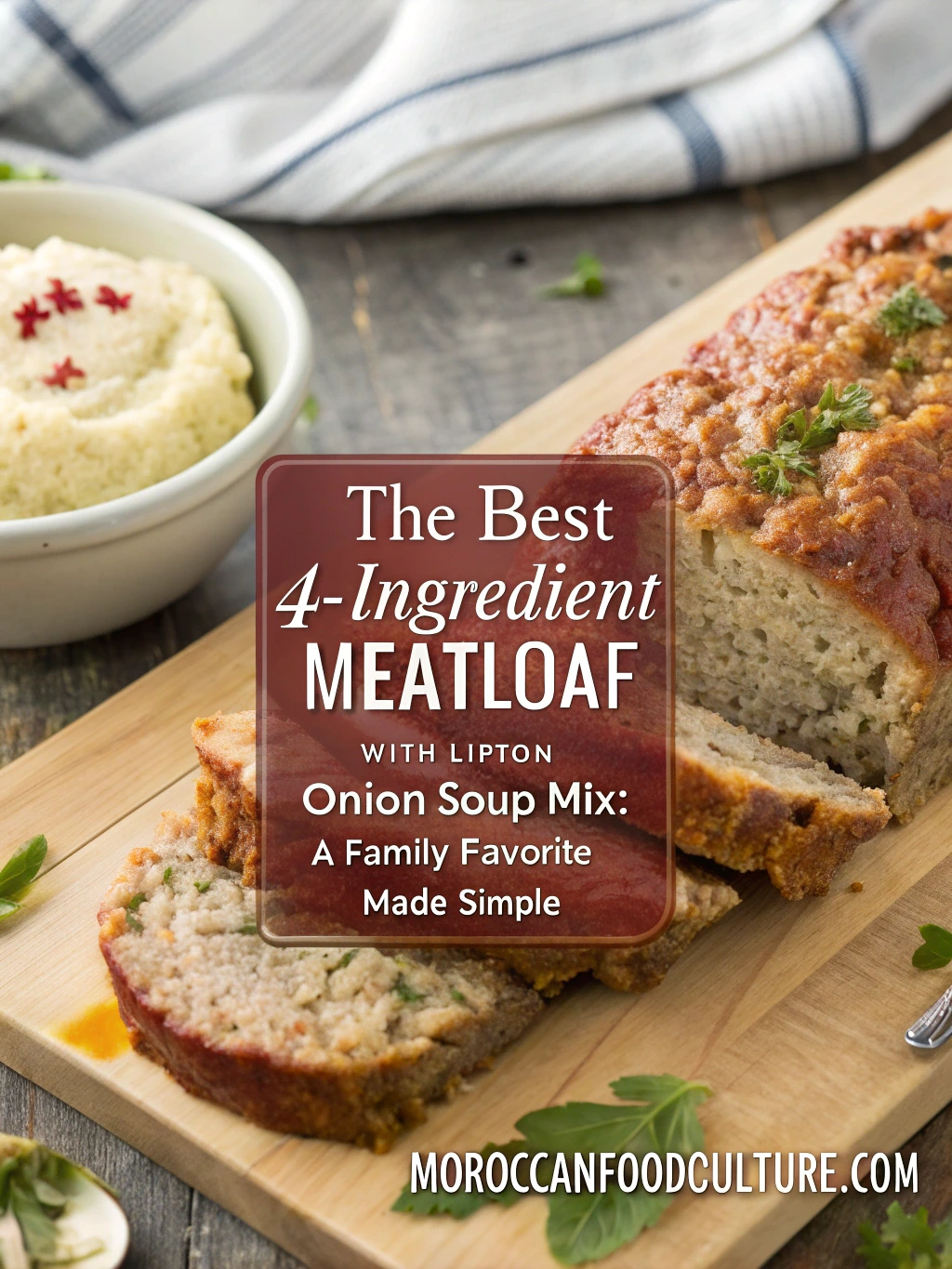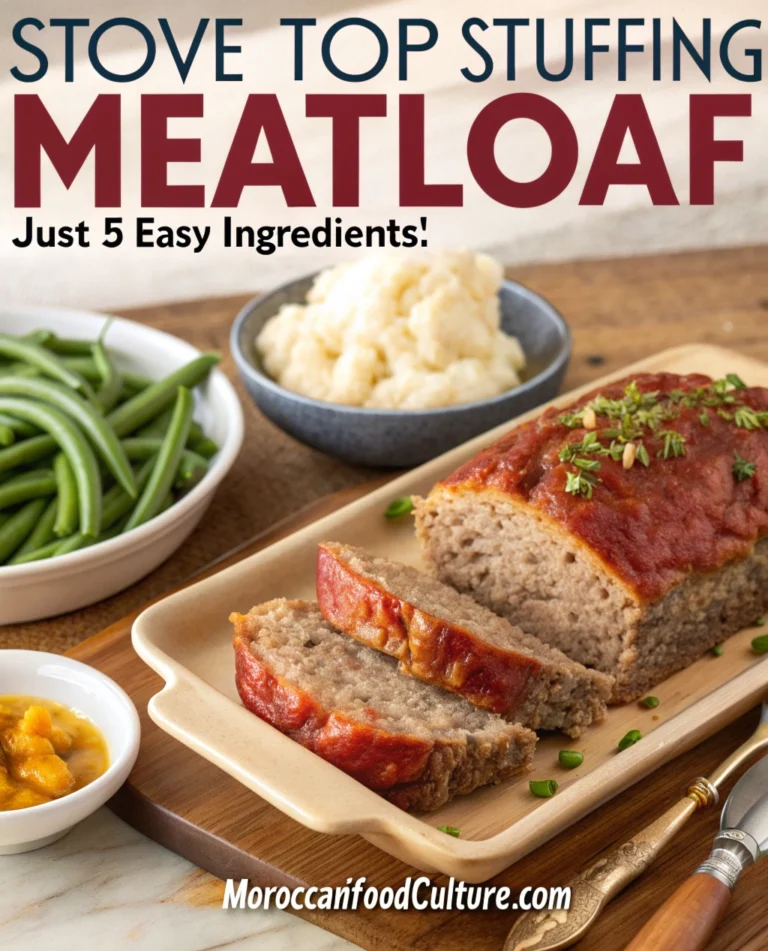The Best 4-Ingredient Meatloaf with Lipton Onion Soup Mix: A Family Favorite Made Simple
There’s something deeply comforting about walking into a home filled with the savory aroma of meatloaf baking in the oven. For me, it brings back memories of Sunday family dinners at my grandmother’s house, where her secret weapon was always that unmistakable packet of Lipton Onion Soup Mix. What if I told you that you could recreate that same heartwarming, delicious meal with just four simple ingredients? This incredibly easy meatloaf with Lipton Onion Soup Mix isn’t just convenient—it’s a time-honored recipe that delivers maximum flavor with minimal effort.
When life gets hectic and you’re stretched for time but unwilling to compromise on a satisfying dinner, this recipe becomes your culinary lifeline. The beauty of a 4-ingredient meatloaf lies not just in its simplicity, but in how those few elements work together to create something truly special. Whether you’re a seasoned cook looking for a reliable standby or someone who finds kitchen endeavors somewhat intimidating, this straightforward approach to meatloaf will quickly earn its place in your regular meal rotation.
Table of Contents

Why This Meatloaf Recipe Stands Out
Time-Saving Wonder
Let’s face it—modern life rarely affords us the luxury of spending hours in the kitchen, especially on weeknights when schedules collide and hunger strikes with urgency. This meatloaf recipe acknowledges that reality while refusing to sacrifice quality. With prep time under 10 minutes, you’ll spend less time assembling and more time enjoying both the cooking aromas and the finished product.
Unlike traditional meatloaf recipes that demand chopping onions (and the inevitable tears), mincing garlic, measuring multiple seasonings, and preparing various ingredients, this streamlined version eliminates those steps entirely. The packet of Lipton Onion Soup Mix serves as your all-in-one flavor solution, providing perfectly balanced seasonings without any measuring spoons or cutting boards required.
Simply open, pour, mix, and shape—your meatloaf is ready for the oven faster than you can set the table. This efficiency makes it perfect for those evenings when you’re juggling homework help, household chores, or simply wanting to maximize your relaxation time rather than your food preparation efforts.
Budget-Friendly Meal Solution
In an era of rising grocery prices, finding economical meals that don’t feel like compromises has become increasingly important. This meatloaf recipe answers that challenge admirably, utilizing pantry staples and transforming them into a hearty meal that satisfies without straining your wallet.
Ground beef, when purchased in family packs or on sale, remains one of the more affordable protein options available. Combined with the modest cost of a Lipton Onion Soup Mix packet, a couple of eggs, and breadcrumbs (which you can even make from leftover bread), you’re looking at a complete main dish that feeds 4-6 people for under $15 total—often significantly less.
The economics improve even further when you consider the leftover potential. Cold meatloaf sandwiches might actually surpass the original hot dinner in nostalgic appeal for many, and reheated slices maintain their flavor beautifully. Essentially, your initial investment can easily stretch to provide multiple meals, bringing the per-serving cost down to remarkably budget-friendly levels.
Flavor-Packed Simplicity
The magic of this recipe resides in how the Lipton Onion Soup Mix creates depth of flavor that belies the minimal ingredient list. Food scientists have long understood that complex flavor profiles don’t necessarily require lengthy ingredient lists—sometimes fewer components working harmoniously yield superior results.
The soup mix contains dehydrated onions, which rehydrate during cooking and release their essential oils throughout the meat mixture. These oils carry flavor compounds that penetrate the entire loaf. Additionally, the mix contains a carefully calibrated blend of salt, garlic powder, onion powder, and other umami-rich elements that would take a substantial spice rack to recreate from scratch.
This umami factor—that elusive fifth taste associated with savory satisfaction—is particularly abundant in the Lipton mix. The concentrated flavors simulate the slow-cooked depth normally achieved only through lengthy preparation, effectively providing a shortcut to complex flavor development without sacrificing quality.
The 4 Essential Ingredients
At the heart of this recipe’s appeal is its remarkably short shopping list. Just four ingredients transform into a hearty, satisfying main course that tastes like you spent hours preparing it.
| Ingredient | Amount | Why It’s Important |
|---|---|---|
| Ground beef | 2 pounds | Provides the base and hearty texture |
| Lipton Onion Soup Mix | 1 packet | Delivers instant seasoning and flavor |
| Eggs | 2 large | Binds ingredients together |
| Breadcrumbs | ¾ cup | Creates ideal texture and moisture retention |
The ground beef forms the foundation of your meatloaf, providing protein, structure, and substantial texture. While standard 80/20 lean-to-fat ground beef delivers optimal flavor and moisture, you can adjust according to dietary preferences. Leaner options work perfectly well, especially since the other ingredients help maintain moisture.
The Lipton Onion Soup Mix packet is your flavor workhorse, instantly infusing the meat with a perfect balance of onion, salt, and savory elements that would otherwise require numerous individual ingredients and considerably more preparation time. This single addition elevates the entire dish from basic to memorable.
Eggs serve as the crucial binding agent that holds everything together. During cooking, the proteins in eggs coagulate, helping your meatloaf maintain its shape rather than crumbling when sliced. They also contribute to the rich, satisfying texture of the finished dish.
Finally, breadcrumbs perform multiple vital functions—they help absorb and retain moisture, prevent the meatloaf from becoming too dense, and contribute to the ideal final texture. They create tiny pockets throughout the loaf as they absorb juices, resulting in a tender bite rather than a heavy, solid mass.
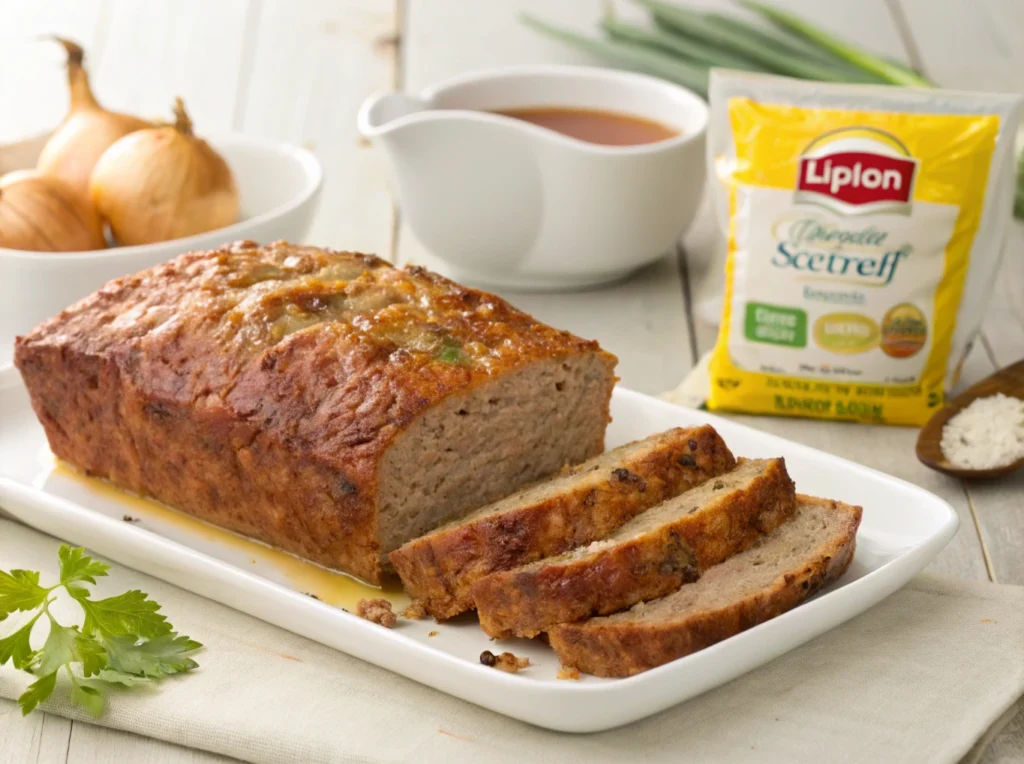
Step-by-Step Meatloaf Preparation
Preparing Your Kitchen
Before diving into mixing your ingredients, taking a moment to prepare your kitchen properly sets you up for success. Position an oven rack in the middle position and preheat your oven to 350°F (175°C). This moderate temperature allows the meatloaf to cook evenly without drying out the exterior before the interior reaches food-safe temperature.
Equipment needs remain minimal—a large mixing bowl, a measuring cup for the breadcrumbs, and either a loaf pan or baking sheet, depending on your preferred shaping method. If using a loaf pan (typically 9″x5″), consider lining it with parchment paper extending over the sides to form handles, making removal effortless. For free-form loaves, line a rimmed baking sheet with foil or parchment for easier cleanup.
Having a meat thermometer on hand, while not strictly necessary, removes any guesswork regarding doneness—aim for 160°F (71°C) at the center of the loaf.
Mixing Your Meatloaf
In your large mixing bowl, combine the ground beef, Lipton Onion Soup Mix, eggs, and breadcrumbs. When incorporating these elements, gentle handling becomes crucial. Over-mixing compacts the meat proteins too tightly, resulting in a dense, tough texture rather than the tender bite you’re seeking.
Use clean hands (the best tools for this job) to mix just until ingredients appear evenly distributed throughout the meat. The mixture should hold together when pressed but not feel overly compacted. If it seems too wet and doesn’t hold shape, gradually add additional breadcrumbs, a tablespoon at a time. Conversely, if it feels too dry or stiff, a tablespoon of milk or even water can help achieve the ideal consistency.
A useful test: form a small patty in your palm. If it holds together without feeling overly sticky or crumbly, your consistency is perfect.
Shaping and Baking Techniques
You have two primary options for shaping your meatloaf: using a loaf pan or creating a free-form loaf on a baking sheet. Each offers distinct advantages.
The loaf pan method provides structure and uniform cooking, particularly beneficial for those newer to meatloaf-making. Simply transfer your mixture to the prepared pan and gently press to eliminate major air pockets without compacting the meat excessively.
The free-form approach allows better browning on all sides and lets fat drain away more effectively. To shape, transfer your mixture to a parchment-lined baking sheet and form into a loaf approximately 9 inches long and 5 inches wide, with an even height of about 2 inches. Slightly round the top while keeping the shape relatively uniform for even cooking.
Place your shaped meatloaf in the preheated oven and bake for approximately 55-65 minutes. If adding a glaze (discussed below), apply it around the 40-minute mark to allow proper caramelization without burning.
Optional Glaze Variations
While technically moving beyond the strict four-ingredient limit, adding a simple glaze elevates your meatloaf from wonderful to unforgettable. The classic approach combines ½ cup ketchup, 2 tablespoons brown sugar, and 1 teaspoon vinegar (apple cider or white), creating a sweet-tangy topping that caramelizes beautifully.
For those preferring a more savory finish, combine ⅓ cup ketchup with 1 tablespoon Worcestershire sauce and 1 teaspoon Dijon mustard. This creates a deeper, more complex flavor profile without excessive sweetness.
Whichever glaze you choose, brush it onto the partially cooked meatloaf around 15-20 minutes before the end of cooking time. This timing allows the glaze to set and caramelize without burning or becoming too dark.
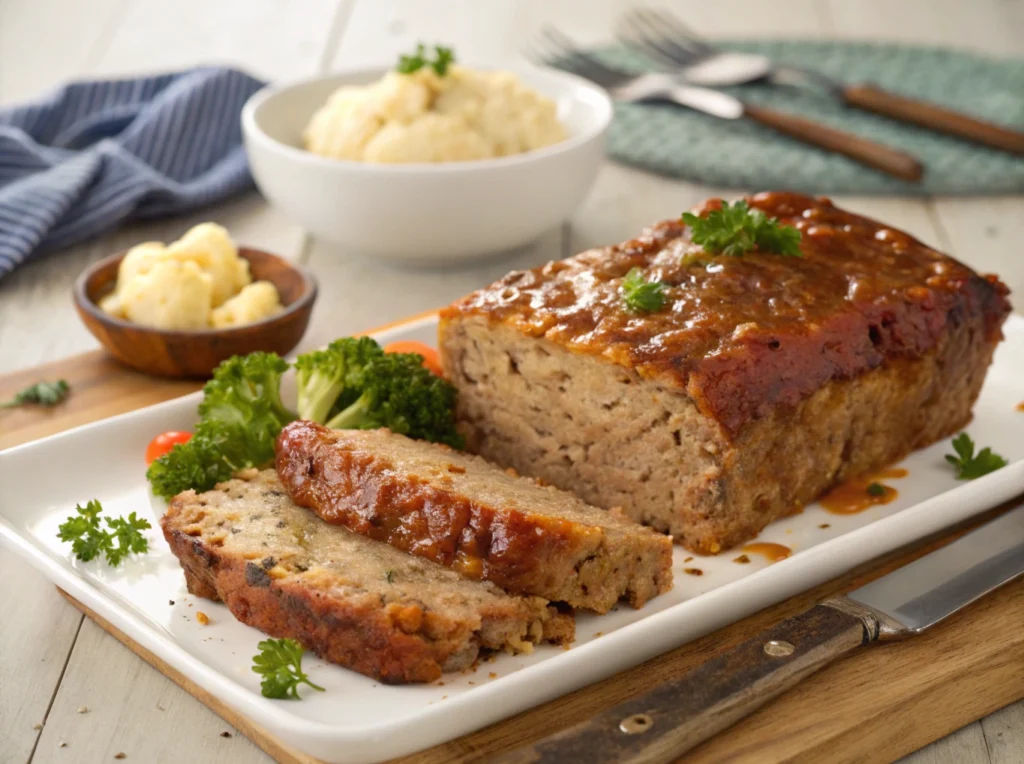
Tips for Meatloaf Perfection
Texture Troubleshooting
The perfect meatloaf strikes a delicate balance—moist without being soggy, firm enough to slice cleanly yet tender with each bite. Achieving this ideal sometimes requires small adjustments.
If your previous meatloaves have turned out dry, several factors might be responsible. Using meat that’s too lean (90% or higher) removes necessary fat that keeps the loaf moist. Consider either selecting 80/20 ground beef or compensating with additional moisture if using leaner meat. Adding 2-3 tablespoons of milk, beef broth, or even barbecue sauce to the mixture helps maintain moisture.
Conversely, if your meatloaf seems too wet or falls apart when sliced, insufficient binding might be the culprit. Allow the cooked meatloaf to rest for at least 10 minutes before slicing—this resting period permits proteins to set and juices to redistribute. For future batches, slightly increasing your breadcrumb amount or adding an extra egg can provide the structure needed for clean slices.
The ideal firmness allows the meatloaf to hold its shape when sliced while still feeling tender rather than dense when eaten. This comes from proper ingredient ratios combined with gentle mixing technique—remember that over-mixing creates toughness by compacting meat proteins too tightly.
Flavor Enhancements
While this recipe shines in its simplicity, occasional variations keep family meals interesting. Compatible herbs like fresh parsley (about 2 tablespoons, chopped) or dried thyme (½ teaspoon) integrate beautifully with the onion flavors from the soup mix.
When considering garlic additions, restraint serves you well since the soup mix already contains some garlic elements. A single clove, finely minced, enhances without overwhelming the balanced flavor profile. Add it directly to the mixing bowl with your other ingredients.
Cheese incorporated into meatloaf creates pockets of gooey, savory goodness throughout. About ¾ cup of shredded cheese works perfectly—try sharp cheddar for distinctive flavor or mozzarella for stretchy, mild appeal. Mix most of the cheese directly into the meat mixture, reserving a small amount to sprinkle on top during the last 15 minutes of baking.
Make-Ahead and Storage
Life often demands flexibility, and this recipe accommodates hectic schedules beautifully. You can prepare the raw meatloaf mixture up to 24 hours ahead, shaping it in the pan or on a baking sheet, covering tightly with plastic wrap, and refrigerating until you’re ready to bake. Allow an extra 5-10 minutes of cooking time when starting with cold meat.
For longer-term planning, shaped raw meatloaf freezes exceptionally well. Wrap tightly in plastic wrap followed by aluminum foil or place in an airtight container. Freeze for up to three months. Thaw completely in the refrigerator (typically overnight) before baking as directed.
After enjoying your freshly baked meatloaf, proper cooling techniques preserve both safety and quality. Allow leftover meatloaf to cool no longer than two hours at room temperature before refrigerating in airtight containers. Consume refrigerated leftovers within 3-4 days.
When reheating, gentle methods maintain moisture best. For microwave reheating, cover slices with a damp paper towel and heat at 50% power in 30-second intervals until warmed through. In a conventional oven, place slices in a baking dish with 1-2 tablespoons of beef broth, water, or sauce, cover with foil, and warm at 325°F until heated through.
Serving Suggestions
Classic Side Pairings
Few culinary pairings achieve the timeless appeal of meatloaf alongside fluffy mashed potatoes. The creamy texture of well-prepared potatoes provides the perfect counterpoint to the hearty meatloaf, while both benefit from a drizzle of gravy if desired. For an elevated touch, incorporate roasted garlic or a small amount of sour cream into your mashed potatoes.
Vegetable accompaniments balance the plate both nutritionally and visually. Bright green beans simply steamed and finished with a pat of butter complement the meatloaf beautifully. Glazed carrots offer sweet notes that play well against the savory main dish. For something slightly less conventional, roasted Brussels sprouts provide pleasant textural contrast and sophisticated flavor.
Bread options round out the meal and provide something to soak up those delicious meat juices. Soft dinner rolls, a slice of crusty French bread, or even cornbread pairs wonderfully, depending on your family’s preferences.
Modern Twists
While traditional plating certainly satisfies, contemporary approaches to serving meatloaf have emerged to keep this classic fresh and exciting. Meatloaf sandwiches represent perhaps the most beloved alternative presentation—try thick-cut bread (sourdough works particularly well), a smear of mayo mixed with a touch of horseradish, crisp lettuce, and a slice of tomato alongside your cold or reheated meatloaf slice.
For family meals with visual appeal, consider meatloaf “cupcakes”—divide your meat mixture among the cups of a muffin tin, bake for about 25 minutes, then top each with a dollop of mashed potatoes piped on with a star tip to resemble frosting. These individual portions cook faster than a full loaf and delight diners of all ages.
Deconstructed meatloaf bowls offer a trendy, customizable dinner option. Start with a base of mashed potatoes, add crumbled meatloaf, then top with roasted vegetables, gravy or sauce, and garnishes like fresh herbs or crispy fried onions. This approach works beautifully for repurposing leftovers while creating something that feels entirely new.
Nutritional Information
While comfort food isn’t typically celebrated for nutritional profiles, understanding the approximate nutrient content helps you incorporate this meal into a balanced diet. The values below represent estimates per serving, assuming 6 servings from the recipe:
| Nutrient | Amount Per Serving | % Daily Value |
|---|---|---|
| Calories | 320 | – |
| Protein | 28g | 56% |
| Carbohydrates | 12g | 4% |
| Fat | 18g | 23% |
| Sodium | 620mg | 27% |
| Fiber | 1g | 4% |
The substantial protein content supports muscle maintenance and provides lasting satisfaction, helping prevent hunger soon after eating. The moderate fat content, primarily from the beef, delivers flavor and contributes to the meatloaf’s moisture. While sodium levels reflect the seasoning from the soup mix, balancing your meal with low-sodium sides keeps overall intake manageable.
For those monitoring specific nutritional concerns, several adjustments work well with this recipe. Using leaner ground beef (90/10) reduces fat and calories. Low-sodium versions of the soup mix cut approximately 30% of the sodium content. Adding finely chopped vegetables like bell peppers or grated carrots increases fiber and nutrients while maintaining the loaf’s texture.
Conclusion
This 4-ingredient meatloaf with Lipton Onion Soup Mix proves that extraordinary meals don’t require complicated recipes or extensive ingredient lists. By focusing on quality ingredients that work harmoniously together, you can create a meatloaf that rivals those made with dozens of components. The genius lies in how these few simple elements—ground beef, Lipton Onion Soup Mix, eggs, and breadcrumbs—transform into something greater than their sum.
Next time you’re craving comfort food but short on time, remember this simple yet satisfying recipe—it might just become your new family tradition. The beauty of this meatloaf isn’t just in its simplicity, but in how it brings people together around the table, creating moments and memories that last far longer than the meal itself.
In a world that often feels overwhelming with complexity, there’s profound satisfaction in turning to recipes that deliver reliability, flavor, and comfort without demanding excessive effort or ingredients. This meatloaf represents cooking at its most fundamental and rewarding—transforming basic components into a meal that nourishes both body and spirit.
Why not make this meatloaf your dinner plan tonight? With ingredients likely already in your kitchen and minimal prep time required, you’re less than 90 minutes away from gathering your loved ones around a meal that tastes like you’ve been cooking all day.
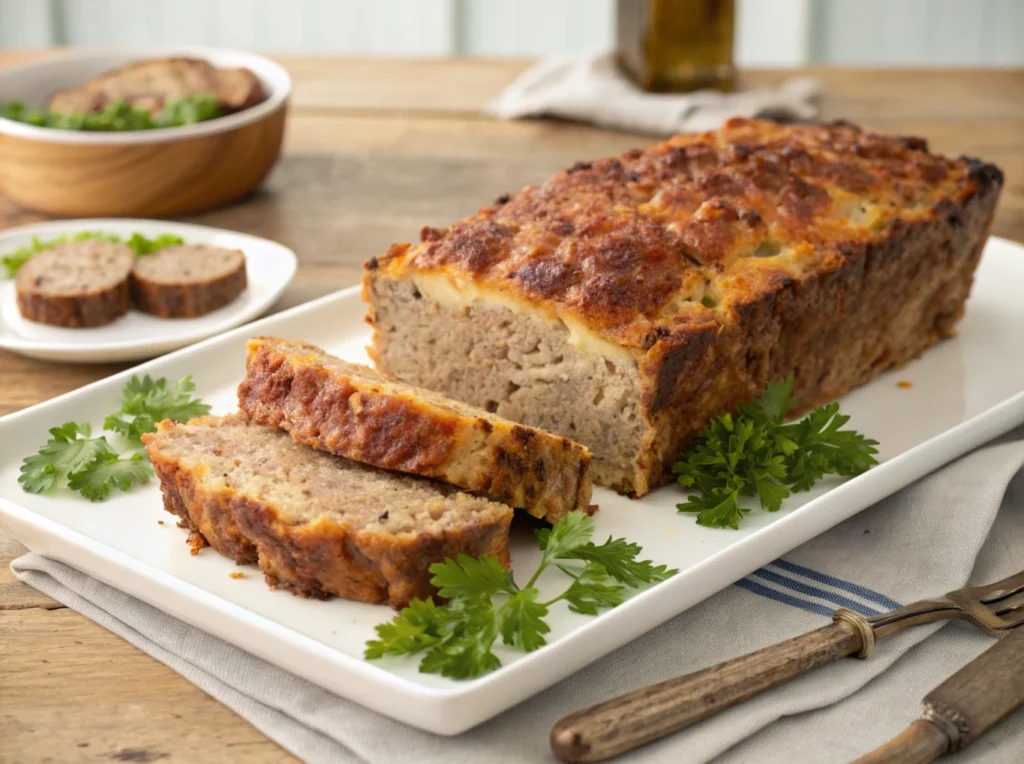
Frequently Asked Questions
Can I make this 4-ingredient meatloaf with Lipton Onion Soup Mix ahead of time?
Yes, you can prepare the meatloaf mixture up to 24 hours in advance and refrigerate it until you’re ready to bake. Simply combine all ingredients, shape in your pan or on a baking sheet, cover tightly with plastic wrap, and refrigerate. When ready to cook, remove from the refrigerator, let sit at room temperature for 15 minutes while your oven preheats, then bake as directed, adding 5-10 extra minutes to account for the chilled starting temperature.
What type of ground beef works best for meatloaf with Lipton Onion Soup Mix?
An 80/20 lean-to-fat ratio provides the best flavor and moisture for this meatloaf recipe. This balance ensures enough fat to keep the meatloaf juicy while preventing it from becoming greasy. If using leaner meat for dietary reasons, consider adding 2-3 tablespoons of milk or beef broth to maintain moisture levels.
Can I substitute the breadcrumbs in this meatloaf with Lipton Onion Soup Mix?
Absolutely! Try crushed crackers, oatmeal, or gluten-free alternatives in equal amounts. Crushed Ritz crackers add buttery richness, while saltine crackers provide texture with neutral flavor. Quick oats offer a nuttier profile and boost fiber content. For gluten-free options, gluten-free breadcrumbs, crushed rice crackers, or certified gluten-free oats work perfectly well. Each alternative maintains the necessary binding and moisture-retention properties.
How do I know when my Lipton Onion Soup Mix meatloaf is fully cooked?
Use a meat thermometer to ensure the internal temperature reaches 160°F (71°C) at the center. Insert the thermometer into the thickest part of the loaf without touching the bottom of the pan. Without a thermometer, look for clear juices running from the meatloaf when pierced with a knife, and check that the meat has turned from pink to brown throughout. A properly cooked meatloaf should feel firm when gently pressed.
What makes Lipton Onion Soup Mix so effective in meatloaf recipes?
The concentrated blend of onions, salt, and savory spices in Lipton Onion Soup Mix provides instant depth of flavor that would normally require numerous ingredients and longer cooking times. The dehydrated onions rehydrate during cooking, distributing their flavor throughout the meat while creating small pockets of texture. The mix also contains perfectly balanced salt and seasonings that enhance the beef’s natural flavors without requiring individual measuring or mixing.
Can I freeze leftover meatloaf made with Lipton Onion Soup Mix?
Yes, cooked meatloaf freezes exceptionally well for up to 3 months when wrapped properly. For best results, cool completely, then slice before freezing for easier portioning later. Wrap individual slices in plastic wrap followed by aluminum foil, or place in freezer-safe containers with parchment paper between slices. Thaw overnight in the refrigerator before reheating, or reheat from frozen at a lower temperature for longer time until warmed through.
Is there a low-sodium alternative for meatloaf with Lipton Onion Soup Mix?
You can use Lipton’s reduced-sodium version or make your own onion soup mix substitute with onion powder, dried herbs, and a reduced amount of salt. To create your own lower-sodium alternative, combine 1/4 cup dried minced onion, 2 teaspoons onion powder, 1 teaspoon garlic powder, 1/2 teaspoon celery seed, 1/2 teaspoon black pepper, and 1/2 teaspoon salt (rather than the 1-2 teaspoons in regular mixes). This homemade version delivers similar flavor with approximately 50-60% less sodium than the original packet.
Have you given our recipe a try?
There are no reviews yet. Be the first one to write one.
